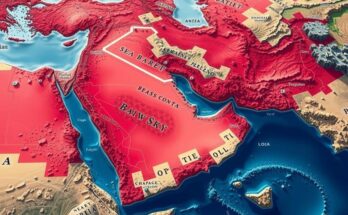Eastern Cuba was shaken by a 6.8 magnitude earthquake near Santiago, leading to reports of building damage and aftershocks. The quake struck at a depth of 14 km with no tsunami threat posed. It is part of a series of recent natural disasters impacting recovery efforts in the region.
On Sunday, eastern Cuba experienced a powerful earthquake, measuring 6.8 on the Richter scale, as reported by the U.S. Geological Survey. The earthquake’s epicenter was located near Bartolomé Masó in Granma province, close to Santiago de Cuba, the nation’s second-largest city. Local residents recounted feeling the tremor intensely; buildings shook violently, and there were reports of items falling from shelves. Some property damage was noted in the nearby town of Pilón, with many structures in the area being older and more susceptible to earthquakes. Residents reported feeling at least two aftershocks, and although there was significant fear during the event, no severe damages to homes were initially reported. The quake struck at a depth of 14 kilometers and was initially recorded at a lower magnitude of 5.8 before being revised. Fortunately, the U.S. National Tsunami Warning Center indicated that there was no tsunami threat associated with this seismic activity. This earthquake adds to a series of recent natural disasters that have impacted the region, including Hurricane Oscar in October and Hurricane Rafael, which resulted in a massive power outage affecting millions. Recovery efforts are ongoing, and the prevalence of rolling blackouts in eastern Cuba continues to hinder communication and recovery initiatives. According to experts, most seismic activity within Cuba occurs around Santiago, due to a fault line marking the boundary between tectonic plates.
Cuba is located near a significant geological boundary that runs along its southeastern coast, which makes it particularly susceptible to seismic activity. The island has a troubled history of natural disasters, including hurricanes that have caused damage to infrastructure and power grids. The recent earthquake compound the challenges faced by the region, already suffering from effects of prior natural events. Recovery from these disasters often involves extensive efforts due to the vulnerability of many buildings and the infrastructure in place, which predominantly consists of older structures.
The eastern region of Cuba is currently grappling with the aftermath of a significant earthquake, measuring 6.8 in magnitude. This seismic event occurred near Santiago de Cuba, a city known for its historical significance and vulnerability to earthquakes. Although there were initial reports of damage and fear among residents, early assessments indicate no severe structural failures. This incident highlights the ongoing challenges faced by Cubans, especially following a tumultuous series of natural disasters recently experienced in the area.
Original Source: www.canberratimes.com.au




